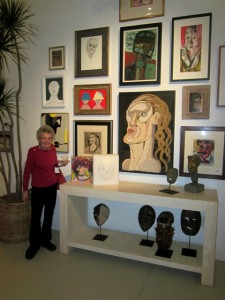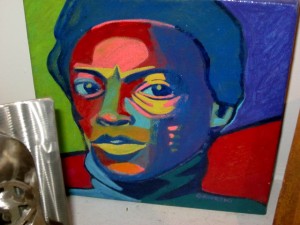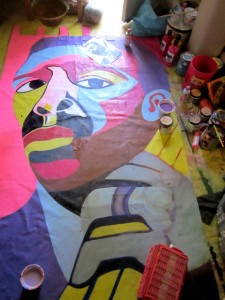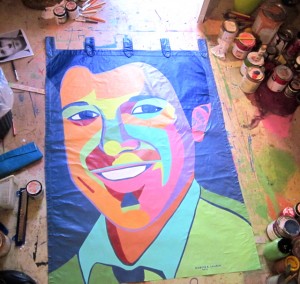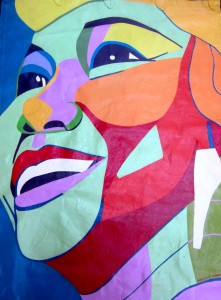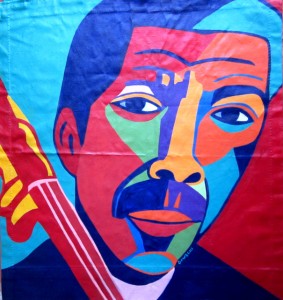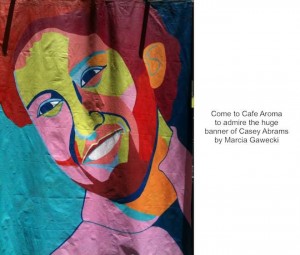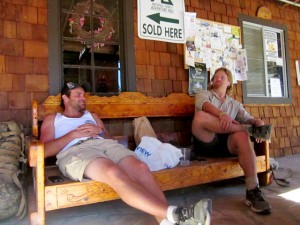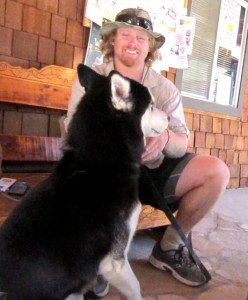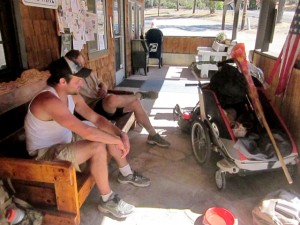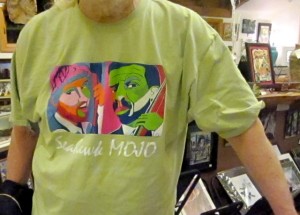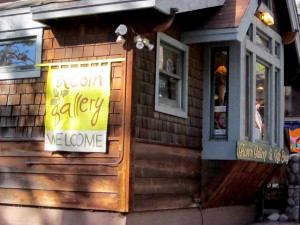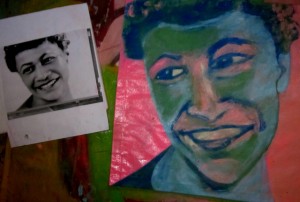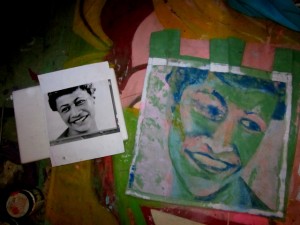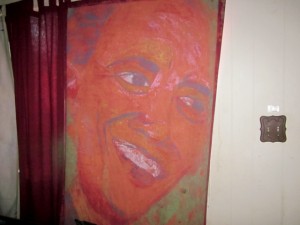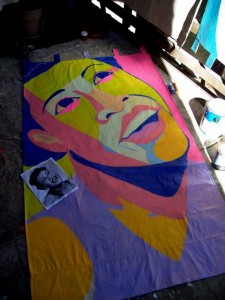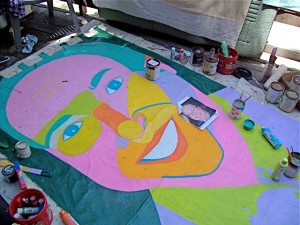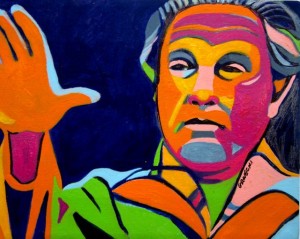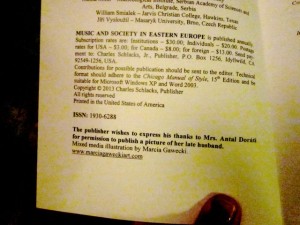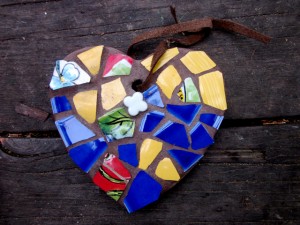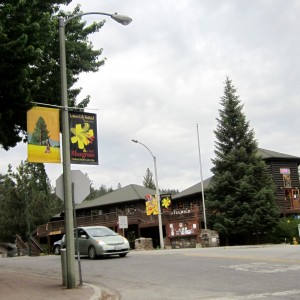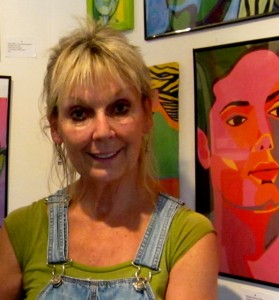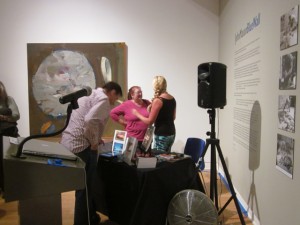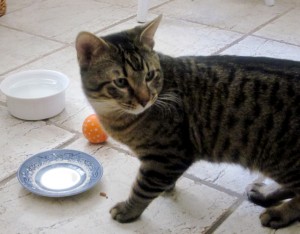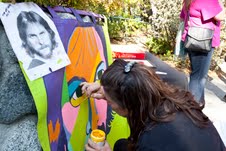
Marcia Gawecki at Idyllwild Art & Wine Walk. Photo by Peter Zabadi.
By Marcia E. Gawecki
Ever since I was young, I’ve always hated painting in public. My dad was stationed in the Phillippine Islands, and my sister and I took watercolor lessons from an old Filapino painter. He didn’t saymuch, but with his paintings, he spoke volumes.
During our lessons, it was customary for students to paint along the walkway into the gallery and shop. People would often stop and watch awhile. My sister, Beth, was definitely a better painter, and found a way to block out any distractions, including visitors.
For me, however, I would suddenly become self-conscious, and fumble with my paint, taking on too much paint or water, and creating an instant mess. Visitors would leave in embarassment, knowing that they caused the commotion.
It got to the point that I would rush through a painting in the early part of our lesson so it would be nearly done by the time that the nosy customers would walk by. Or worse yet, stop and watch.
Because of this, I almost stopped painting. But then I realized that most artists paint in private.
Over the years, when I lived in Omaha, Chicago, and now Idyllwild, gallery owners have encouraged me to paint in public. I would immediately refuse, saying I was too shy, or my canvas was too big for it to work.
Then I’d secretly watch the other artists that agreed to paint outside. One painter working outside the former Artisans Gallery in Oakwood Village, had them captivated. People were drinking wine and milling about, and occasionally would ask her questions, about where she lived, what medium she used, and how long she had been painting.
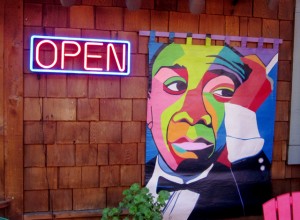
Louis Armstrong outside Acorn Gallery Idyllwild.
38 x 50 1/2 inches.
She responded with patience and grace. Then she noticed a squirrel digging and running up a nearby tree, and included it in her painting! Needless to say, I was amazed! She ended up selling a couple of paintings. I think it had something to do with the outdoor connection.
But that still didn’t convince me to paint in public. My palms still get sweaty at the thought of it. Then I managed to get my portraits in the Acorn Gallery, next to Cafe Aroma. I started watching the gallery two days a week.
Kirsten Ingbretsen, the owner who is also a mixed-media artist, would encourage me to paint inside or outside the gallery. She was very casual about it.
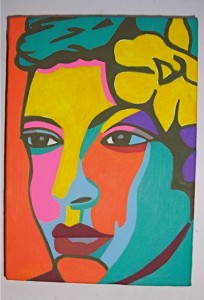
Billie Holiday is on display at the Acorn Gallery in Idyllwild
Then the Idyllwild Art and Wine Walk arrived, and two of the Acorn artists had agreed to paint outside on the deck. They set up their easels and table, and made it inviting. I wasn’t sure if I wanted to participate, but I set up my banner of Tim Weisberg next to a chair in the parking lot. My back was to everyone who were busy drinking wine, so it was easy to handle.
I decided to get over it.
It was OK until people started getting rowdy and nearly spilled their wine on my back. However, I met some interesting people, and maybe got a commission out of one encounter.
The next week, when I would set out the easels and sculptures on Acorn’s deck, I could see traces o red paint left over from Kirsten’s art projects. At first, I tried to scrape the paint away, but it was stubborn. Scrubbing it was like scraping up frosting left over from a birthday party.
One day, I decided to paint outside under the umbrella, hoping to attract more visitors to the gallery. I was working on a sign that I needed for an art booth. However, I noticed that the longer I painted outside, the less people came into the gallery. They seemed to go the long way around the steps to Cafe Aroma.
I felt like an art troll guarding the door of the gallery. No one would dare cross me, unless they could comment about my painting. Little did they know, it was the last thing I wanted!
So I moved inside. Believe it or not, Kirsten did not object to painting on her glass desk, next to the counter. It was tucked away in the far corner, so visitors didn’t really see me working there until later.
I’m not sure when I started painting there regularly, but it was a matter of necessity. I had some commissions to finish before Christmas and was running out of time. At first, I would just paint the backs of the banners, something that I’d always leave for last. Then I kept adding colors to the back, and pretty soon it looked like an abstract!
When I started working on the front. At the time, I was working on a portrait of baseball pitcher Sandy Koufax. When people would come in, I’d immediately stop painting. I’d even cover it with a towel or a nearby folder, and go help them.
Then people started asking about the paintings.
“Oh, you do those bright portraits?” they’d ask. “What are you working on?” “Hey, that looks exactly like him!”
Sometimes, I’d go into detail about what kind of paint I used, or why I decided to paint on tab-topped curtains. Then I’d point out the other prints in the gallery, and the conversation would go into another direction.
These encounters were innocent enough, and really didn’t produce any sales. People were just curious about what you were doing. Kind of like if I were to see a woodworker whittling away at a piece of wood. I would stop and watch too.
But inside, I still was the young girl who was afraid of messing up.
Then yesterday, I had an encounter with a young artist. Her name was Gabriela, and she and her parents were looking around the gallery. They were from a rural town in Northern California.
Gabby was asking pointed questions about Kirsten’s work that was on display on an easel. This particular one was intense and theraputic. I explained that Kirsten paints about her experiences, and in this case, about a fight she had with her friend.
“She painted this painting a few years ago right after an argument, and then put it away,” I told Gabby, who was looking at the Buddah and sailboats at the top of the painting. “Then she painted this part later. You can do that, you know, finish a painting years later.”
Gabby’s mother saw my paints on the desk, and mentioned that Gabby got an easel and several canvases for Christmas.
“What kind of paint do you use?” she asked.
“I use Behr acrylic paint from Home Depot,” I explained. “I have them mix the $3 samples in bright colors. They have screw on lids, so I don’t spill the paint while I’m painting on my kitchen floor.”
People are always amazed that artists will just paint in the middle of a room. That’s nothing! I know of a sculptor who built a clay pot in the middle of his living room while his wife was away! However, she threatened to leave him if he did it again!
Then Gabby’s dad showed me one of Gabby’s recent paintings on his cell phone. It was an incredible painting of a sunset. There were reds, yellows and blues, with lots of movement. My heart was full!
“How old is Gabby?” I asked.
“Six years old,” her mother replied.
Then I understood why they were a little apprehensive. At that young age, Gabby had real talent. She could even be great, if she kept it up. I tried not to jump up and down and shout that they had the next van Gogh on their hands! Instead, I took their lead and remained calm.
“You should frame it,” I suggested. “It’s really good!”
Gabby beamed.
Her mother said she had put the sunset up in her room. I could tell that they probably didn’ t have much money, and were overwhelmed with what they were going to do with her. I wanted to suggest private lessons, but in the rural area where they lived, there probably was limited resources.
So I suggested that they get large canvases from thrift stores, and paint over those ugly paintings.
“You can use white or any color to cover it, and sometimes there’s texture from the previous painting that you can use in your own landscapes,” I suggested.
Gabby liked the idea, and I asked her if she painted from nature, or out of her head.
“For the sunset, I painted what I saw. My parents like to look at sunsets,” she said. “But other times, I paint from out of my head.”
Artists who can paint from imagination or memory are a different breed.
Then I handed her a poster that I had done of Casey Abrams that showed all the bright colors, explaining that it was OK to give him a green face and purple hair.
I’m not sure how much of what I said sunk in with Gabby. My guess is that she would be light years ahead of me in no time. But she seemed like a well-adjusted young girl, curious about the world.
After they left for Humber Park searching for the last traces of snow, I looked back at Kirsten’s desk. My paint tubs were lined up like little soldiers, while the brushes were resting in the small water cup. The portrait was half hidden, but it was a definite mess.
Then I realized then that I would never have had that art conversation with Gabby had I not been painting in public. I would have said hi to her, and talked about the holiday or the weather, and that would’ve been it.
I would have missed Gabby’s sunset.
Copyright 2013 Marcia Gawecki Art. All rights reserved.
